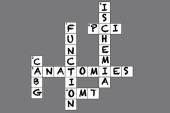No Difference in 1-Year QoL Between FFR-Guided PCI and CABG: FAME-3
The timeline varied, though, with PCI-treated patients better off early and surgical patients needing more time to recover.

WASHINGTON, DC—For patients with three-vessel coronary artery disease undergoing revascularization, there is no significant difference in quality of life (QoL) at 1 year among those treated with PCI guided by fractional flow reserve (FFR) and those treated with CABG surgery, a new analysis from the FAME-3 shows.
Not surprisingly, QoL was better early for patients treated with PCI with a drug-eluting stent as opposed to the more-invasive bypass surgery, but the two procedures largely equalized at 12 months, report researchers.
William Fearon, MD (Stanford University School of Medicine, CA), who led the FAME-3 study and this new analysis, said the clinical event rate in the trial was quite low, a finding that speaks to the excellent outcomes achieved in both treatment arms and justifies a look at differences in QoL.
“When there isn’t that big a difference between the two treatments, things like quality of life become much more important,” he told TCTMD. “That’s why this study is relevant. To patients, these small differences in repeat revascularization, for example, aren’t as relevant as they might be to us as physician/scientists. Things that are more important to them are things such as how they feel, how quickly they can get back to work, and how much angina they have. This quality-of-life substudy shows there aren’t any differences in quality of life at 1 year, and I think that’s important information.”
Allen Jeremias, MD (St. Francis Hospital, Roslyn, NY), who wasn’t involved in the trial, called the quality-of-life analysis a touch “curious” given that FAME-3 showed FFR-guided PCI failed to demonstrate noninferiority compared with surgery.
“Quality of life is pretty standard to do in a trial that’s quote, unquote positive,” said Jeremias. “In this particular case, where PCI is not noninferior to surgery, the truth is that CABG is better.” That said, while it may appear odd to perform a quality-of-life analysis on a treatment that is worse than the comparator, Jeremias said that FAME-3 may be the rare exception where it’s warranted.
“When you’re looking at the outcomes, and you tell a patient that at 1 year survival without any major cardiac events is 94.8% with CABG and 92.7% with PCI, and your overall survival is 99.1% with CABG and 98.4% with PCI,” he said, “but you’re not going to have a higher risk of major bleeding, renal failure, or atrial fibrillation with PCI and also you’re quality of life is much better early on and you can go to work, then maybe that’s a fair discussion to have in the context of shared decision-making.”
William Boden, MD (Boston University School of Medicine/VA New England Healthcare System, MA), told TCTMD that the quality-of-life results aren’t particularly surprising, specifically the different time lines showing better early results with CABG. “Beyond 1 month, we really see no differences overall, which is consistent with prior trials,” he said. This analysis, he added, also appears to prop up the subjective benefits of PCI despite the procedure being “not noninferior” to CABG surgery when it comes to harder outcomes.
“That’s the critical factor I think most physicians are interested in when making the [revascularization] decision,” said Boden.
Narrowing Between SYNTAX and FAME-3
The FAME-3 quality-of-life analysis was published April 2, 2022, in Circulation and presented as part of a featured research session at the American College of Cardiology (ACC) 2022 Scientific Session by Frederik Zimmermann, MD (Catharina Hospital, Eindhoven, the Netherlands).
To recap the primary FAME-3 results: FFR-guided PCI failed to demonstrate noninferiority when compared with CABG surgery for the primary endpoint of death from any cause, MI, stroke, or repeat revascularization in 1,500 patients with three-vessel CAD. At 1 year, the primary composite endpoint of death from any cause, MI, stroke, or repeat revascularization occurred in 10.6% of patients treated with FFR-guided PCI and in 6.9% of those treated with surgery, a difference that missed the noninferiority margin established by investigators (upper boundary < 1.65 for the 95% CI of the HR).
Like Fearon, Zimmermann noted that the rate of MACCE with PCI and CABG surgery was much lower in FAME-3 than in other trials, such as SYNTAX. In FAME-3, the absolute difference in MACCE between PCI and surgery was 3.7%, as opposed to 5.4% in SYNTAX, with both trials favoring CABG surgery. Given the narrowed difference between procedures over time, “the impact of FFR-guided PCI versus CABG surgery on quality of life, chest pain, and work status becomes more important for clinical decision-making,” said Zimmermann.
For the primary endpoint of the European Quality of Life-5 Dimensions (EQ-5D) summary score, a measure that captures mobility, self-care, usual activities, pain/discomfort, and anxiety/depression, there was no significant difference between the two procedures at 12 months. Similarly, the EQ visual analogue scale (EQ-VAS), which is used for patients to provide a global assessment of their overall health, did not differ at 12 months.
EQ-5D and EQ-VAS scores improved significantly from baseline to 1 month in both groups, but there was a different trajectory of improvement between FFR-guided PCI and CABG. Patients undergoing PCI had a better quality of life at 1 month compared with surgery, but this advantage was neutralized by 1 year.
The percentage of patients with CCS class ≥ 2 angina was similar between PCI and surgery, and so was the percentage of patients working full- or part-time at 12 months. In a subgroup analysis, a larger percentage of PCI-treated patients younger than 65 years were working full- or part-time at 12 months compared with the surgery group.
“I think it’s very positive data . . . to help advise our patients,” said Fearon.
Long Follow-up Needed
To TCTMD, Boden noted that 6.3% of patients treated with FFR-guided PCI had CCS class ≥ 2 angina at 1 month compared with 2.5% of those undergoing surgery. By 12 months, the difference between treatments wasn’t statistically significant but numerically the trend still favored surgery (6.2% with PCI vs 3.1% with CABG surgery). The finding suggests some discordance between the patient-reported EQ-5D and EQ-VAS findings and physician-documented CCS angina scores, Boden suggested.
Shamir Mehta, MD (McMaster University/Population Health Research Institute, Canada), who wasn’t involved in the study, said that while there was no difference in quality of life between PCI and surgery on the EQ-5D, that metric tends to be less sensitive than the Seattle Angina Questionnaire (SAQ). For this reason, he wondered whether the SAQ might have detected any differences between the two revascularization strategies at 1 year.
“These quality-of-life analyses for studies in patients with angina are very important, because angina affects patients in different ways,” he told TCTMD. “Some patients can be really quite impaired.”
During the Q&A session following the presentation, Zimmerman also emphasized shared decision-making with the heart team, noting that some patients might be willing to accept a slightly higher risk if their QoL is better in that first year. He said the FAME-3 investigators plan to study patients beyond 1 year to see if there is any difference in clinical outcomes between the two therapies. The benefits of CABG surgery tend to accrue over time and whether this translates into better QoL remain to be seen, say investigators.
Michael O’Riordan is the Managing Editor for TCTMD. He completed his undergraduate degrees at Queen’s University in Kingston, ON, and…
Read Full BioSources
Fearon WF, Zimmermann FM, Ding VY, et al. Quality of life after fractional flow reserve-guided PCI compared with coronary bypass surgery. Circulation. 2022;Epub ahead of print.
Disclosures
- Fearon reports research funding from Abbott, Medtronic, and Boston Scientific; he reports consulting for Siemens and CathWorks and owns stock options with HeartFlow.





Comments